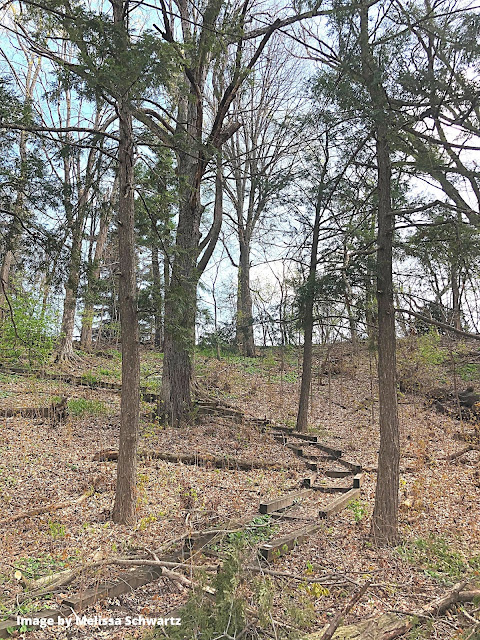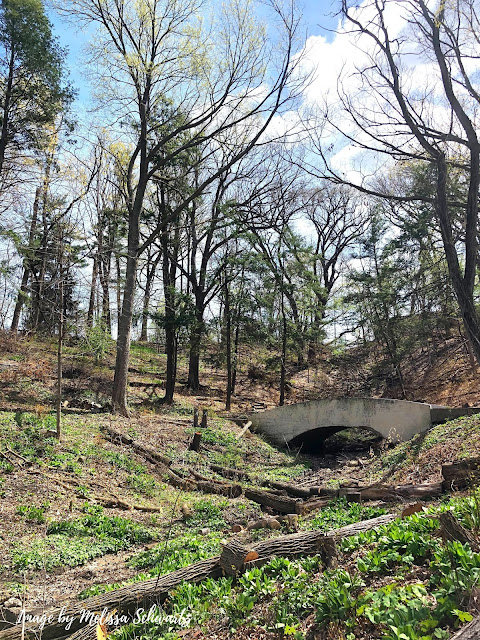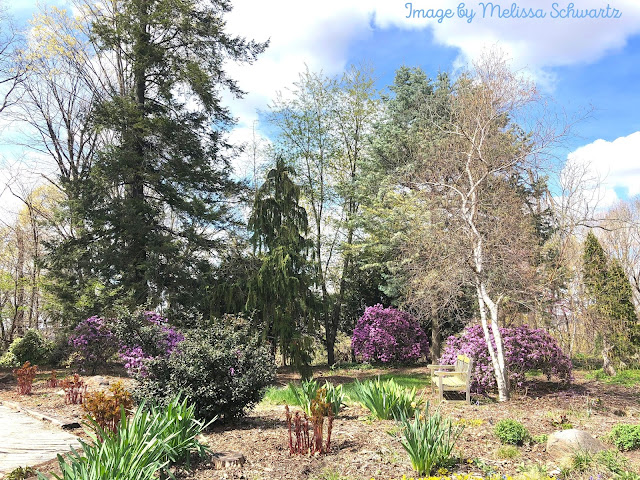Admiring a Jens Jensen Garden and Fascinating Local History at the Hauberg Estate in Rock Island, Illinois
Disclosure: Thank you to Visit Quad Cities for hosting my trip to the Quad Cities in order to share incredible experiences with my audience. Opinions are 100% my own.
The Hauberg Estate rises as a majestic architectural treasure from atop a hill in Rock Island, Illinois. Touring the estate introduced us to magnificent gardens as well as the interesting history of the estate. Immediately upon first entering the grounds, I knew an afternoon of admiring beautiful landscaping, nature inspired architecture and interesting stories would unfold.
 |
| The Hauberg Estate wows in a regal form as you walk up the entry path. |
A Little Hauberg Estate History
While we primarily visited the Hauberg Estate to tour the gardens, the history of Susanne Denkmann Hauberg and John Hauberg fascinated us. Susanne was the daughter of a successful lumber baron. She became a great philanthropist and established the West End Settlement which provided services for poor residents. She also established the Rock Island YWCA and children's camps among other endeavors. Susanne Denkmann had the Hauberg Estate constructed beginning in 1909. I was totally impressed by Susanne's accomplishments and philanthropic efforts and would love to learn more.
John Hauberg grew up on the farm. We learned a little about his love of education and reading. He eventually became a lawyer and helped with Native American causes. John also shared Susanne's charitable spirit. On my first visit to the Quad Cities, I visited Black Hawk State Historic Site which is also home to the John Hauberg Museum which holds his collection of Native American artifacts and tells the story of Sauk and Meskwaki people. Pretty neat to learn more about John Hauberg!
 |
| Prairie style art glass windows highlight the nature outdoors. |
Constructed from 1909-1911, architect Robert C. Spencer employed the Prairie style emphasizing simplicity, nature and craftsmanship in the design of the Hauberg Estate. We fell in love with the art glass windows which highlighted the nature outside of the home and had lovely tulip designs in the glass. Tulips were a particular favorite of Susanne Denkmann Hauberg and were incorporated throughout.
Interesting Fact: In 1927, Crown Prince Gustaf of Sweden stayed at the Hauberg Mansion while on a visit to Augustana College.
 |
| The white pines of Jen Jensen's garden design are reminiscent of the forests of Wisconsin. |
Exploring the World of Jens Jensen
The gardens of Hauberg Mansion were designed by famed landscape architect Jens Jensen. Jens Jensen focused on highlighting native nature. We learned that while Jensen was in the German military, he visited the formal gardens of German cities. He noted the gardens were not of the people highlighting more exotic and harder to maintain flowers. He set out to design his gardens for the people using native flora.
 |
| The treelined hilly landscape delighted us. We found it full of woodpeckers! |
When he emigrated from Denmark to the United States, he began working for the West Chicago Park District as a street cleaner. Eventually, he was promoted to the job of Gardener. He began to replace dying exotic plants with native wildflowers thus establishing the American garden. Jensen would incorporate native foliage in his gardens throughout his life. I really felt very in tune with Jensen because I too resculpted my yard to include more natives.
Jensen understood the changing tableau that native flora creates as well as understood how the landscape would mature, die and regenerate. He would incorporate this within his designs. After learning more about Jensen, it is no wonder that he became an instrumental champion of conservation.
 |
| The hilly landscape added an interesting element to the gardens of Hauberg Estate. |
The land on which the Hauberg Estate was built was initially a large open meadow for cattle grazing. Jensen would sculpt this land to include woodlands reminiscent of those in Wisconsin, terraced food gardens full of fruiting trees, open meadow and a formal rose garden in which he did still incorporate natives including the native rose Rosa setigura. Originally, a stream tumbled down as a waterfall into three pools.
 |
| Above is the ravine where the spring will come down the hill creating a waterfall and pools. |
We enjoyed taking a tour of the gardens at the Hauberg Estate admiring the remnants of Jensen's design as well as the work currently being completed to restore it. The extensiveness of the gardens truly surprised me as we walked the grounds. The landscape promises to truly awe once the restoration has been completed.
Interesting Fact: Of the 350 gardens Jens Jensen designed in the USA, only 35 intact Jensen gardens remain including the Hauberg garden.
 |
| An original light pole at Hauberg Estate resembles bark. |
On our walk, we learned so many interesting tidbits. Our guide pointed out original plants including peonies that were just coming up. We learned about changes to the drives. One of the original light poles that resembles the bark of tree still stands. Additionally, we walked along the remnants of the original brick. We learned that some of workers left their names in the bricks. Pretty cool!
 |
| Workers left their names in brick and are part of the history of Hauberg. |
Admiring the Spring Gardens of Hauberg Estate
 |
| Spring adds an extra joy to Hauberg's gardens. |
We also explored some of garden areas that had been updated. They were already showing the blush of spring! The gardens adjacent to the home looked idyllic for reposing.
 |
| Hauberg Estate's tulip fountain delights! |



Post a Comment